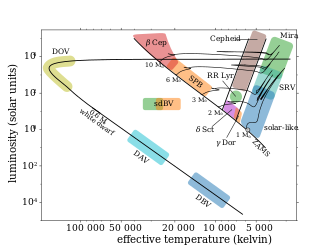
Oscillation is the repetitive or periodic variation, typically in time, of some measure about a central value or between two or more different states. Familiar examples of oscillation include a swinging pendulum and alternating current. Oscillations can be used in physics to approximate complex interactions, such as those between atoms.
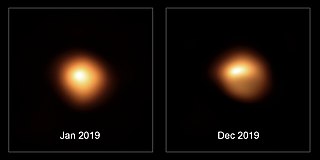
A variable star is a star whose brightness as seen from Earth changes with time. This variation may be caused by a change in emitted light or by something partly blocking the light, so variable stars are classified as either:
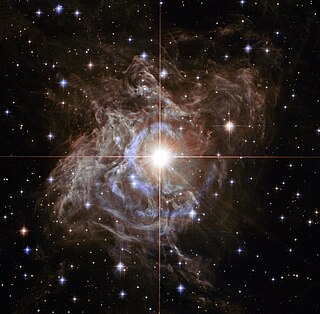
A Cepheid variable is a type of variable star that pulsates radially, varying in both diameter and temperature. It changes in brightness, with a well-defined stable period and amplitude.

CoRoT was a space telescope mission which operated from 2006 to 2013. The mission's two objectives were to search for extrasolar planets with short orbital periods, particularly those of large terrestrial size, and to perform asteroseismology by measuring solar-like oscillations in stars. The mission was led by the French Space Agency (CNES) in conjunction with the European Space Agency (ESA) and other international partners.
Helioseismology, a term coined by Douglas Gough, is the study of the structure and dynamics of the Sun through its oscillations. These are principally caused by sound waves that are continuously driven and damped by convection near the Sun's surface. It is similar to geoseismology, or asteroseismology, which are respectively the studies of the Earth or stars through their oscillations. While the Sun's oscillations were first detected in the early 1960s, it was only in the mid-1970s that it was realized that the oscillations propagated throughout the Sun and could allow scientists to study the Sun's deep interior. The modern field is separated into global helioseismology, which studies the Sun's resonant modes directly, and local helioseismology, which studies the propagation of the component waves near the Sun's surface.
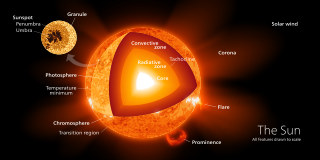
Stellar structure models describe the internal structure of a star in detail and make predictions about the luminosity, the color and the future evolution of the star. Different classes and ages of stars have different internal structures, reflecting their elemental makeup and energy transport mechanisms.

Delta Scuti, Latinized from δ Scuti, is a variable star in the southern constellation Scutum. With an apparent visual magnitude that fluctuates around 4.72, it is the fifth-brightest star in this small and otherwise undistinguished constellation. Analysis of the parallax measurements place this star at a distance of about 199 light-years from Earth. It is drifting closer with a radial velocity of −45 km/s.

A Delta Scuti variable is a subclass of young pulsating star. These variables as well as classical cepheids are important standard candles and have been used to establish the distance to the Large Magellanic Cloud, globular clusters, open clusters, and the Galactic Center. The variables follow a period-luminosity relation in certain passbands like other standard candles such as Cepheids. SX Phoenicis variables are generally considered to be a subclass of Delta Scuti variables that contain old stars, and can be found in globular clusters. SX Phe variables also follow a period-luminosity relation. One last sub-class are the pre-main sequence (PMS) Delta Scuti variables.
Beta Cephei variables, also known as Beta Canis Majoris stars, are variable stars that exhibit small rapid variations in their brightness due to pulsations of the stars' surfaces, thought due to the unusual properties of iron at temperatures of 200,000 K in their interiors. These stars are usually hot blue-white stars of spectral class B and should not be confused with Cepheid variables, which are named after Delta Cephei and are luminous supergiant stars.

Gamma Doradus variables are variable stars which display variations in luminosity due to non-radial pulsations of their surface. The stars are typically young, early F or late A type main sequence stars, and typical brightness fluctuations are 0.1 magnitudes with periods on the order of one day. This class of variable stars is relatively new, having been first characterized in the second half of the 1990s, and details on the underlying physical cause of the variations remains under investigation.

The unqualified term instability strip usually refers to a region of the Hertzsprung–Russell diagram largely occupied by several related classes of pulsating variable stars: Delta Scuti variables, SX Phoenicis variables, and rapidly oscillating Ap stars (roAps) near the main sequence; RR Lyrae variables where it intersects the horizontal branch; and the Cepheid variables where it crosses the supergiants.
Solar-like oscillations are oscillations in stars that are excited in the same way as those in the Sun, namely by turbulent convection in its outer layers. Stars that show solar-like oscillations are called solar-like oscillators. The oscillations are standing pressure and mixed pressure-gravity modes that are excited over a range in frequency, with the amplitudes roughly following a bell-shaped distribution. Unlike opacity-driven oscillators, all the modes in the frequency range are excited, making the oscillations relatively easy to identify. The surface convection also damps the modes, and each is well-approximated in frequency space by a Lorentzian curve, the width of which corresponds to the lifetime of the mode: the faster it decays, the broader is the Lorentzian. All stars with surface convection zones are expected to show solar-like oscillations, including cool main-sequence stars, subgiants and red giants. Because of the small amplitudes of the oscillations, their study has advanced tremendously thanks to space-based missions.
A pulsating white dwarf is a white dwarf star whose luminosity varies due to non-radial gravity wave pulsations within itself. Known types of pulsating white dwarfs include DAV, or ZZ Ceti, stars, with hydrogen-dominated atmospheres and the spectral type DA; DBV, or V777 Her, stars, with helium-dominated atmospheres and the spectral type DB; and GW Vir stars, with atmospheres dominated by helium, carbon, and oxygen, and the spectral type PG 1159. GW Vir stars may be subdivided into DOV and PNNV stars; they are not, strictly speaking, white dwarfs but pre-white dwarfs which have not yet reached the white dwarf region on the Hertzsprung-Russell diagram. A subtype of DQV stars, with carbon-dominated atmospheres, has also been proposed, and in May 2012, the first extremely low mass variable (ELMV) white dwarf was reported.
Rapidly oscillating Ap stars (roAp stars) are a subtype of the Ap star class that exhibit short-timescale rapid photometric or radial velocity variations. The known periods range between 5 and 23 minutes. They lie in the δ Scuti instability strip on the main sequence.
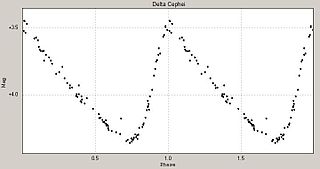
Stellar pulsations are caused by expansions and contractions in the outer layers as a star seeks to maintain equilibrium. These fluctuations in stellar radius cause corresponding changes in the luminosity of the star. Astronomers are able to deduce this mechanism by measuring the spectrum and observing the Doppler effect. Many intrinsic variable stars that pulsate with large amplitudes, such as the classical Cepheids, RR Lyrae stars and large-amplitude Delta Scuti stars show regular light curves.
The kappa opacity mechanism is the driving mechanism behind the changes in luminosity of many types of pulsating variable stars. The term Eddington valve has been used for this mechanism, but this is increasingly obsolete.

SX Phoenicis is a variable star in the southern constellation Phoenix. With an apparent visual magnitude ranging around 7.33, it is too faint to be readily seen with the naked eye and requires binoculars. It is located 272 light years from the Sun, as determined from an annual parallax shift of 12 mas.

V529 Andromedae, also known as HD 8801, is a variable star in the constellation of Andromeda. It has a 13th magnitude visual companion star 15" away, which is just a distant star on the same line of sight.

FG Virginis is a well-studied variable star in the equatorial constellation of Virgo. It is a dim star, near the lower limit of visibility to the naked eye, with an apparent visual magnitude that ranges from 6.53 down to 6.58. The star is located at a distance of 273.5 light years from the Sun based on parallax measurements, and is drifting further away with a radial velocity of +16 km/s. Because of its position near the ecliptic, it is subject to lunar occultations.

HD 49434 is a single star in the equatorial constellation of Monoceros. It is faintly visible to the naked eye with an apparent visual magnitude of 5.75. Based on parallax measurements the star is located at a distance of 130.5 light years from the Sun, but it is drifting closer with a radial velocity of −17 km/s.

















